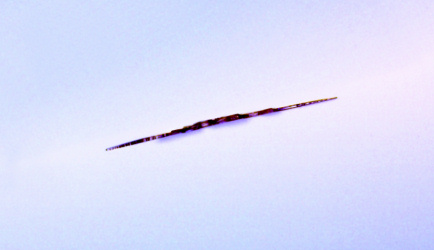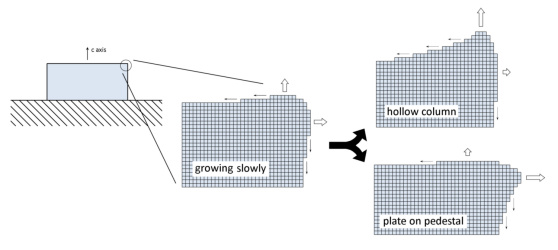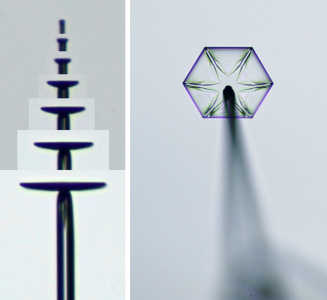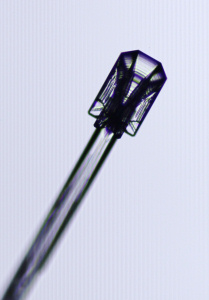|
|
 Thin and Flat Thin and Flat
One
often-overlooked quality of stellar snow crystals is that they are
remarkably thin and flat. This photo shows one seen from the side. This
is why we call them snow flakes.
Then
again, snow crystals are not always thin, flat, plates. Some look
like slender needle crystals. The different forms appear at
different temperatures, as shown in the snow crystal morphology diagram.
This
all begs the question: How is it that snow crystals can grow into such
extreme shapes -- extremely thin, flat plates and extremely long,
slender needles? |
|  The Sharpening Instability The Sharpening Instability
Part of the answer to this question lies in an edge-sharpening growth instability.
It sounds complicated, and it is a bit. Turns out the growth of a
faceted surface depends on the width of the facet. When last molecular
terrace is less than 100 molecules wide (roughly), it becomes
especially easy for molecules to attach to the top of the terrace.
Strange, but that seems to be part of how ice works.
This
quality tends to sharpen the crystal edges. As shown in this diagram,
when a corner grows, it produces narrow faceted terraces. A narrow
terrace grows faster than a wide terrace, and the growth then adds more
terraces that are even narrower than before. The result is an
edge-sharpening growth instability.
One
big problem remains with this: we do not know the molecular cause of
the terrace-width dependence in the growth, which underlies the
edge-sharpening instability.. More than anything else, this is what
currently limits our understanding of the snow crystal morphology diagram. |
|  Plates on Needles Plates on Needles
We
study how all this works by growing ice crystals in the snowflake lab.
The images on the left shows a thin plate growing on the tip of an
electric ice needle.
The composite image shows a side view at different times. The other
photo shows the plate face on. The edges of the plate grow out rapidly
once the edges become thin and sharp.
From the imaging data we
measure the grow velocities, and then try to model everything on the
computer. The sharpening instability is necessary to make sense of all
these measurements, so we are fairly confident this is a real thing.
Still, we are collecting more data, under all different conditions,
just to be sure. |
|  Cups on Needles Cups on Needles
This shows a photo of a cup-shaped crystal growing on the end on an electric ice needle. This time it is the edges of the column that become thin and sharp from the edge sharpening instability.
It's unfortunate that ice crystal growth is so complicated, with faceting, branching,
and edge sharpening all going on simultaneously. But, all this
complicated physics is why snow crystals look so intriguing. Next
time you see it snow, try to imagine all the things going on in the
winter clouds. |
| Scientific references to the edge-sharpening instability:
Explaining
the formation of thin ice crystal plates with structure-dependent
attachment kinetics, by Libbrecht, KG, JOURNAL OF CRYSTAL GROWTH
Volume: 258 Issue: 1-2 Pages:
168-175 Published: OCT 2003.
[This describes the basic idea of the instability.]
Measurements
of surface attachment kinetics for faceted ice crystal growth,
by Libbrecht, Kenneth G.; Rickerby, Mark E., JOURNAL OF CRYSTAL
GROWTH Volume: 377 Pages: 1-8 Published:
AUG 15 2013.
[A related paper, measuring the growth rates of faceted ice crystals.]
Observations of an Edge-enhancing Instability in Snow Crystal Growth near -15 C, by Kenneth G. Libbrecht, arXiv:1111.2786 (2011).
[Describes quantitative evidence for the edge-sharpening instability.]
An Edge-Enhancing Crystal Growth Instability Caused by Structure-Dependent Attachment Kinetics, by Kenneth G. Libbrecht, arXiv:1209.4932 (2012).
[Better evidence for the edge-sharpening instability. These data are difficult to explain any other way.]
Toward
a Comprehensive Model of Snow Crystal Growth Dynamics: 2. Structure
Dependent Attachment Kinetics near -5 C, by Kenneth G. Libbrecht, arXiv:1302.1231 (2013).
[More experimental evidence with quantitative modeling of the instability, this time at -5C.]
Toward
a Comprehensive Model of Snow Crystal Growth Dynamics: 1. Overarching
Features and Physical Origins, by Kenneth G. Libbrecht, arXiv:1211.5555 (2013).
[A related paper, describing my ideas about an overarching physical model for snow crystal growth.]
|
|
|
|
